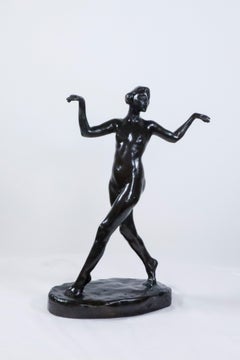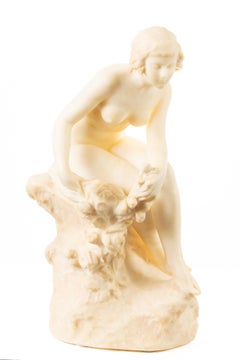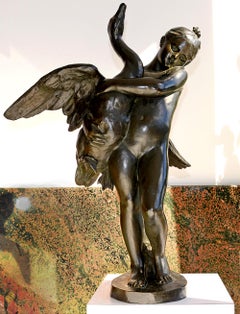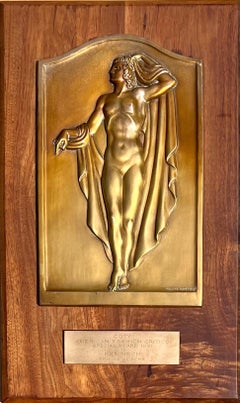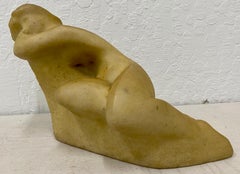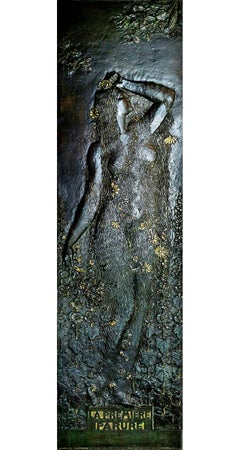1910s Nude Sculptures
to
1
7
3
1
2
1
Overall Height
to
Overall Width
to
1
1
7
6
5
4
2
2
2
1
1
1
1
1
12
61
312
697
7
7
21
16
2
9
24
25
38
33
5
1
1
1
1
5
5
1
1
1
Period: 1910s
To The Ultimate Do We Pursue The Ideal
By Paul Manship
Located in Concord, MA
This is an iteration of Paul Manship's medal that features the artist Barry Faulkner on the obverse, and the inscription of that version is marked "Barry Faulkner Painter MXMXV (1915...
Category
American Modern 1910s Nude Sculptures
Materials
Bronze
Dancing Nude Bronze of a Woman "Femme Dansant, 1910"
Located in Brookville, NY
Dancing Nude Bronze by Charles Rumsey is one of many figures he depicted of women. He has usually been known for his sculptures of horses, polo players, wildlife and dogs, mainly du...
Category
1910s Nude Sculptures
Materials
Bronze
Franz Bergmann Orientalist Arab Slave Nude Group Cold Painted Bronze Signed 1910
Located in Portland, OR
A very large 24" (61cm) Franz Xavier Bergmann (1861-1936) cold painted bronze group statue, signed, Austria, circa 1910.
The bronze in the Orientalist manner & depicts a young slave ...
Category
Art Nouveau 1910s Nude Sculptures
Materials
Bronze
Nude Young Woman
Located in San Antonio, TX
Charming early 1900s alabaster sculpture of a young maiden, seated nude on a stump. This work dates to the period when the artist was active in Italy, during this time Ceccarelli's w...
Category
Romantic 1910s Nude Sculptures
Materials
Alabaster
Nude Girl and Swan Bronze
Located in Miami, FL
This stylized figural study captures a young girl restraining a struggling swan trying to take flight purportedly by Marius Jean Antonin Mercié, bearing the incised signature “Mercié” on the base.. The work is quite heavy weighing in about 65 lbs and boasts an opulent dark patina. Unlike his signature work Gloria Victis, that has numerous versions, reproductions and casts, Girl and Swan may be of just a few casts or may be unique.
With Barbedienne foundry mark on the tree stump behind the left foot. Mercie used Barbedienne for many of his works. Purchased from Toulouse Antiques...
Category
Art Nouveau 1910s Nude Sculptures
Materials
Bronze
Art Deco Diana
By Hans Harry Liebmann
Located in Miami, FL
This is a rare statement piece that commands that eye. It is of museum quality will be the centerpiece of any space. Masterfully crafted details of the human form are finely rendered...
Category
Art Deco 1910s Nude Sculptures
Materials
Bronze
Standing Female Nude After Alexander Archipenko Negress (La Negresse)
By Walt Kuhn
Located in Fairlawn, OH
Illustrated: "Walt Kuhn, Painter, His Life and Work, by Phillip Rhys Adams, page 67, plate 27, Courtesy of Kennedy Galleries-Kuhn Estate
Kuhn’s sculptures were collected by the noted early modernist collector John Quinn (1870-1924). Among the works in Quinn’s collection was the icon Brancusi Portait of Mlle Pogany, the work that inspired Kuhn to create the wood carving “Mask” (FA10815). Mlle Pogany was chosen by Kuhn for exhibition at the Armory Show, 1913. Other sculptures by Kuhn are in the collections of the Smithsonian Museum and the Heckscher Museum.
The group of 15 wood carvings came from the estate of the artist to his daughter Brenda Kuhn.
The Kuhn Estate (Brenda) originally worked with Kennedy Galleries of New York who published a detailed illustrated catalog of offerings from the estate in 1967. The estate left Kennedy Galleries some time prior to 1983. They established estate representation with Barridof Galleries of Portland, Maine in partnership with Salander O’Reilly Galleries Inc. of New York. This partnership published a monograph catalog on the artist in 1984.
Of our group of 15 works, three of the early c. 1913 examples have Salander O’Reilly labels affixed to them. The group of works were involved in the Salander O’Reilly bankruptcy liquidation where they were bought from. There have been several related examples that have come to auction since the year 2000.
In 1912, Kuhn was one of the founders of the organization Association of American Painters and Sculptors, the organizing body for
what became known as The Armory Show, 1913. The Heckscher Museum exhibition, European Modernism, as Told by Americans, gives insight in to Kuhn’s travels, artistic associations and the influences on his artwork.
“In 1912 Kuhn traveled through Europe securing loans from artists and dealers to represent Impressionism, Post Impressionism and the newer strains of art like Fauvism and Cubism. Inspired by these developments, Kuhn tried out Fauvism and Cubism for himself.”
“Kuhn would later become an adviser to collectors like John Quinn and Lillie Bliss, a supporter of the Armory Show and later one of the founders of the Museum of Modern Art.”
Quinn acquired seven Kuhn sculptures in wood, bronze and gilt bronze which are listed in his estate inventory.
This work is directly inspired by an Archipenko sculpture, Negress (La Negresse...
Category
Cubist 1910s Nude Sculptures
Materials
Wood
Related Items
1961 Coty Award Plaque Kenneth Hairdresser Jacqueline Onassis Bronze Fashion
Located in New York, NY
1961 Coty Award Plaque Kenneth Hairdresser Jacqueline Onassis Bronze Fashion
Bronze on wood. The wood plaque measures 12 3/4" by 20 3/4 inches. The bronze plaque itself is 13 3/4 x 8 3/4 inches and the the bronze inscription, which reads "COTY, American Fashion Critics Special Award 1961 to KENNETH of LILY DACHE...
Category
American Modern 1910s Nude Sculptures
Materials
Bronze
Vincent Glinsky Alabaster Reclining Nude Sculpture c.1950
Located in San Francisco, CA
Vincent Glinsky Alabaster Reclining Nude Sculpture c.1950
9" long x 4.5" deep x 7.5" high
Signed at the base
Good vintage condition
Vincent Glins...
Category
Art Deco 1910s Nude Sculptures
Materials
Alabaster
H 7.5 in W 9 in D 4.5 in
White Statuary Aged Marble Torso Man Sculpture Classical Greek Roman Grand Tour
Located in Roma, IT
An aged statuary classical greek roman marble torso sculpture of an athlete, grand tour style central Italy early 20th century.
The nude body of the athlete standing on his right le...
Category
Other Art Style 1910s Nude Sculptures
Materials
Marble
H 18.51 in W 7.09 in D 5.12 in
Bufo Contemporary Bronze Sculpture Nude Boy Marble Stone Male Figure
Located in Utrecht, NL
Bufo Contemporary Bronze Sculpture Nude Boy Marble Stone Male Figure
Wim van der Kant (1949, Kampen) is a selftaught artist. Next to his busy profession as a teacher at a high school, he intensively practises his profession as a sculptor. Only when his work would measure up to his own standards, he decided to present it to the rest of the world. In 1995, he exhibited for the first time with Morren Galleries. Van der Kant desires to sculpt young people who still stand uninhibited and curiously in life. The reason he chooses to sculpt boys is, because he is one himself, this way the subject is closer to him. The anatomy of his figures testify of perfectionism. Van der Kant's subjects show similarities with the sculptures from the Greek and Roman antiquity...
Category
Contemporary 1910s Nude Sculptures
Materials
Marble, Bronze
Free Shipping
H 12.21 in W 7.88 in
All Directions
By Frank Hyder
Located in San Francisco, CA
This artwork titled "All Directions" 1987 is a wood bas-relief by noted American artist Frank Hyder, born 1951. It is signed, dated and titled on the verso. The size of the bas-relief itself is 15 x 18 inches, the over all size is 23.5 x 26.5 inches. The frame has been created by the artist. It is in good condition, the frame has minor original defects as crafted by the artist.
About the artist.
Frank Hyder has participated in more than 150 group shows and has had over 80 solo exhibitions throughout North, South and Central America, including 10 individual exhibitions in New York City. He has been one of the few North Americans to have solo museum exhibitions in Venezuela at the Museo de Arte Contemporaneo de Caracas Sofia Imber (MACCSI), Museo Jacobo Borges, Museo de Arte Contemporaneo Zulia (MACZUL), Museo Universidad de Los Andes and Museo de Arte Contemporaneo de Coro. Other solo museum exhibitions include the Pennsylvania Academy of Fine Art’s Museum of American Art, the Carnegie Museum in California, the La Salle Museum of Art in Philadelphia, and the National Museum of Catholic Art and History in New York. His solo installation “New World”, which debuted at the National Museum of Catholic Art and History in East Harlem, NYC, traveled to the Degenstein Gallery at the Susquehanna University in Selinsgrove, PA, the Anita Shapolsky Foundation in Jim Thorpe...
Category
American Modern 1910s Nude Sculptures
Materials
Wood Panel
Bronze Bust of Apollo Belvedere Grand Tour 19th Century
Located in Rochester, NY
Superb 19th century bronze and gilt bronze bust of the god Belvedere Apollo. Circa 1850. This wonderful grand tour bust is a marvel of refined beauty and elegance, crafted with richl...
Category
1910s Nude Sculptures
Materials
Marble, Bronze
La Belle Epoque Novelle
Located in Wien, 9
John William Mills (born 4 March 1933, London) is an English sculptor.
He studied at Hammersmith School of Art, 1947–54, and at the Royal College of Art, 1956–60. He was a resident ...
Category
Modern 1910s Nude Sculptures
Materials
Marble, Bronze
2 Sculptures: "The Power" & "The Glory" WPA Depression WWII era mid 20th century
Located in New York, NY
2 Sculptures: "The Power" & "The Glory" WPA Depression WWII era mid 20th century by Agnes Yarnall circa 1940s.
Sculptor, painter, poet and artistic historian, Agnes Yarnall has, since the age of six been breathing life into her art.
Renowned as a sculptor, whose commissioned portrayals of contemporary celebrities are prized. She has sculpted Judith Anderson, Edna St. Vincent Millay, Carl Sandburg...
Category
American Modern 1910s Nude Sculptures
Materials
Plaster
Large George Aarons Terracotta Sculpture Relief Art Deco Plaque WPA Artist
Located in Surfside, FL
Two Figures (Mother and son)
9" x 17" terracotta sculpture, signed lower left mounted to wood panel, 15 1/2" x 23 1/2"
George Aarons (born Gregory Podubisky, in St. Petersburg, Russ...
Category
Art Deco 1910s Nude Sculptures
Materials
Wood, Terracotta
Industrial Machine Age American Scene WPA Mid 20th Century 1939 SF World's Fair
Located in New York, NY
Industrial Machine Age American Scene WPA Mid 20th Century 1939 SF World's Fair
HAIG PATIGIAN (American/Armenian, 1876-1950)
Aeronautics Pediments
Two Plaster Casts, c. 1930s
each 13.25 x 14.75 x 6 inches
It's possible these moquettes were created for the 1939 World's Fair, the Golden Gate International Exhibition in San Francisco.
Provenance: Private Collection of Lois M. Wright, Author of "A Catalogue of the Life Works of Haig Patigian, San Francisco Sculptor, 1876-1950),” 1967
Loan to Oakland Museum of California (Oakland, CA)
BIO
Haig Patigian is noted for his classical works, which are especially numerous in public venues in San Francisco, California. Patigian was born in Van, Armenia, which at that time was under Turkish rule. Haig was the son of Avedis and Marine Patigian, both teachers in the American Mission School there. He and his older brother showed an aptitude for art early on and were encouraged by their parents. Their father himself had taken up the new hobby of photography. The 1880s were harsh times, however, for many Armenians under an oppressive rule by the Turkish government. Many people were fleeing to the safety of the United States. Suspicious Turkish authorities accused his father of photographing city structures for the Russian government, and in 1888 he fled for his life to America.
Haigs father made his way to Fresno, California, and began life anew as a ranch hand. Within two years he sent for his wife, as well as Haig, his three sisters and brother, and in 1891 the Patigians made the journey from Armenia. Haigs father, an industrious man, worked on various farms, and eventually bought his own ranch and vineyard. It was among fertile farmland of Fresno that Haig grew up.
Young Haigs education consisted of teachings by his parents and by intermittent attendance in public schools. Although he had dreams of becoming an artist, he did not have the opportunity for formal study of art, and began working long days in the vineyards around Fresno.
At age seventeen, Haig made a step towards his dreams and apprenticed himself to learn the trade of sign painting. In his spare time he nurtured his interest in art by painting nature and life scenes with watercolors and oil paints. When his sign-painting mentor left Fresno, Haig opened his own shop and made a name for himself in the town. San Francisco, in the meantime, had been attracting artists since the Gold Rush and had become a thriving art center. Within a few years, Haig had put aside several hundred dollars to move to San Francisco, joining his brother who was already working there as an illustrator.
In 1899, when he was twenty-three, Haig had saved enough money to enroll at the Mark Hopkins Art Institute in San Francisco. Like many aspiring artists of his time, Patigian supported himself by working as a staff artist in the art department of a local newspaper, and in the winter of 1900, nearing his 24th birthday, Haig began work for the San Francisco Bulletin, producing cartoons, black and white illustrations, as well as watercolors.
In 1902 tragedy struck Haig and his family. His 29-year-old brother died of pneumonia, and then his frail mother died a short time later. Five months more saw his youngest sister, just out of high school, die too. Saddened and depressed, Haig moved out of the studio he had shared with his brother, and into a dilapidated studio in a poor section of town. During this time of sadness, Haig fed a growing interest in sculpture.
In 1904 Haig created what he later called his "first finished piece in sculpture". The work, called "The Unquiet Soul", depicted a man thrown back against a rock while waves lash at his feet. The body was tense and twisted, with one hand, in Haig's own words, "searchingly leaning and clutching the rock, while the other masks his troubled head".
The Press Club of San Francisco, which Haig had joined in 1901, put "The Unquiet Soul" on exhibition and local headlines proclaimed "Local Newspaper Artist Embraces Sculptor's Art", and "First Work Predicts Brilliant Future". With the support of friends and community acclaim, the young illustrator left his newspaper job and became a professional sculptor.
The path of his new career was not easy though. Haig had never made much money working for the newspaper and his father needed help with growing debt from funeral expenses and business problems. From time to time Haig sold some artwork, but also occasionally borrowed from friends to pay the rent. He was the classic 'starving artist'.
In the spring of 1905 a white-bearded 81-year-old stranger knocked on Haig's door. It was George Zehndner, from Arcata, California. Zehndner had been born in Bavaria, Germany in 1824, the son of a farmer. In 1849 he had come to America looking for prosperity, settling in Indiana, where he worked on a farm and learned English. He found his way to the West Coast in 1852. Penniless, he worked in various jobs from San Francisco to Sacramento, then found some luck working in the gold fields of Weaverville in Trinity County, and eventually moving to a farm on 188 acres near Arcata. In his 77th year in May of 1901, Zahndner had taken a trip to San Jose, where he stood in a crowd to see a man he thought much of, President William McKinley. McKinley was popular as 'the first modern president' partially because he realized going out to meet the common person increased his support. In September of that year, however, an anarchist assassinated the president while he stood in a receiving line at the Pan-American Exhibition in Buffalo, New York. Soon after, the city of San Jose erected a statue of the slain president in St. James Park. Zehndner took a second trip to San Jose where he visited the McKinley monument. Touched, Zehndner decided that, no matter the cost, his town of Arcata too would memorialize McKinley.
George Zehndner had read about Haig in a newspaper article and asked if Patigian would create a heroic statue of the late President McKinley for Arcata. When asked how much it would cost, Haig responded, despite his borderline poverty, with the fabulous sum of $15,000. Zehndner agreed. The President was to be portrayed standing, wearing an overcoat, with his feet planted squarely on the ground. In the finished statue, one hand is held out before him in a typical posture of speaking, with the other hand holding the speech as his side. The 9-foot statue...
Category
American Modern 1910s Nude Sculptures
Materials
Plaster
Piano surréaliste, Salvador Dali
Located in Fairfield, CT
Artist: Salvador Dali (1904-1989)
Title: Piano surréaliste
Year: 1984
Medium: Bronze
Edition: 34/350, plus proofs
Size: 26.3 x 15.7 x 12 inches
Condition: Excellent
Inscription: Inci...
Category
Surrealist 1910s Nude Sculptures
Materials
Bronze
La Belle Epoque Novelle
Located in Wien, 9
John William Mills (born 4 March 1933, London) is an English sculptor.
He studied at Hammersmith School of Art, 1947–54, and at the Royal College of Art, 1956–60. He was a resident ...
Category
Modern 1910s Nude Sculptures
Materials
Marble, Bronze
Previously Available Items
Nijinski Dance Ballet Russes American French Woman Sculptor early 20th Century
Located in New York, NY
Nijinski Dance Ballet Russes American French Woman Sculptor early 20th Century , Bronze
12 1/2 “ x 6 1/4” H x 6” W
Sculpted c. 1912 while Hoffman with studying with Rodin. In 1912 she won First Prize the Paris Salon for her new modern way of sculpting movement in bronze with Russian Dancers (Anna Pavlova). Hoffman was the first, other followed her style.
About the sculpture
Vaslav Nijinsky (1889-1950). This bronze is a study from the dance L’apres-midi d’un faune (1910) with music by Debussy. It was a scandalous ballet performed with the Ballet Russes and Paris was in an uproar over his new modern style of choreography and overt sexuality. At the end of the ballet after toying with some nymphs Nijinski pleasures himself on stage with one of their scarves creating the scandal. Paris was in an uproar.
Nijinski begged Auguste Rodin to help him calm the critics. Rodin who was known for his eroticism, wrote a letter to the editor of Le Figaro explaining how great Nijinsky danced and exploded into well… you know. Anyway the French public now turned their energy against Rodin, forgetting Nijinsky. France was negotiating with Rodin to purchase his studio which would become the Musee Rodin after his death and they almost shut those talks down because of his letter to the editor.
Sculptor Malvina Hoffman...
Category
French School 1910s Nude Sculptures
Materials
Bronze
La Première Parure (Eve) -- Art Nouveau oversized bas-relief
By Paul Moreau-Vauthier
Located in Miami, FL
La Premier Parure is a French term for a perfect match, generally used for jewelry and ornamentation. In this case, it is used as a metaphor for Adam and Eve. This monumental bronze ...
Category
Art Nouveau 1910s Nude Sculptures
Materials
Bronze
H 101 in W 28 in D 2.5 in
Nike
By André Vincent Becquerel
Located in Saint Augustine, FL
"Nike" Original Classic Bronze Sculpture by Andre-Vincent Becquerel (France, 1893 - 1981), made shortly after World War I in Paris, c. 1920. Depicting Nike, Goddess of Victory, seate...
Category
Art Nouveau 1910s Nude Sculptures
Materials
Bronze
Recently Viewed
View AllMore Ways To Browse
Paintings With Horse Race
Sale Boat
Sky Blue Hat
French Garden Plans
Naif French
Miniature Mountain
Fighter Pilot
Donald Beacher
New Mexico Rain
Japanese Buddhist Painting
Sam Hill
Gold Womens Crosses
James Turner
Antique Still Life Paintings With Fruit
Napoleonic Paintings
Philadelphia Watch
Pink Bird Sculpture
Hudson Mirror

